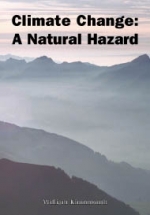Tab Article
The recurring community and environmental impacts of climate extremes, such as the global pattern associated with the El Niño phenomenon, can bring hardship and set back development. It is no accident that those countries that recognise the importance of planning for climate extremes, adequately engineer public infrastructures, and implement appropriate community response strategies are better adapted. When we take a long view, from many decades to centuries, it is important to understand that there are natural fluctuations in climate system. The warming trend of the recent century is not unusual, although a colder climate has been a more persistent characteristic during the past few million years.
Climate Change: A Natural Hazard demonstrates that the simple model of the climate system represented by the IPCC is inadequate as a foundation for future planning. The climate change theory emphasises an expected change in magnitude of radiation processes as an outcome of changing concentrations of anthropogenic greenhouse gases and leads to flawed conclusions. The assumption of a stable climate system ignores natural variability and the occurrence of ice ages and lesser climate fluctuations of the past. The assumption of a climate system forced primarily by the radiation effects of greenhouse gases is a limited perspective of the complex climate system. A more complete description includes interacting phenomena and naturally varying processes associated with the flow of energy through the climate system, including:
• Seasonally varying equator-to-poles solar radiation input,
• The energy reservoir of the warm surface waters of the tropical oceans,
• Energy and momentum exchanges between the land, oceans and atmosphere, and
• Latent energy exchanges as water moves between the oceans, vapour in the atmosphere and snow accumulation over the polar ice sheets and mountain glaciers.
• The computer models that are the basis for IPCC's projections of future climate are misleading because of their rudimentary stage of development. They fail, in a gross sense, to meet the more demanding benchmarks when the description of the climate system is more complete. Failures of the computer models relate to:
• The models systematically underestimate the magnitude of the overturning circulation and atmospheric energy transport. As a consequence, there is erroneous warming of the model troposphere. Deep equatorial convective clouds and the overturning atmospheric circulation of the Hadley Cells are critical processes necessary to distribute excess tropical solar radiation through the troposphere.
• The models systematically underestimate the poleward transport of energy by the ocean circulations. Although the ocean circulations transport only between 10 and 15 percent of the excess energy of the tropics, the spatial sea surface temperature distribution is dependent on the energy budget in the surface mixed layer and is a crucial determinant of the intensity of the atmospheric circulation.
• The models are inconsistent in their representation of longwave radiation at the earth's surface and, on average, overestimate the exchange in the tropics and underestimate the exchange over high latitudes. Net longwave radiation at the surface is the crucial interaction between greenhouse gases and the energetics of the climate system. The magnitudes of the differences between models and the systemic biases, when compared to the expected radiative forcing from increased greenhouse gas concentrations, make nonsense of computer projections of future climate.
The evidence is that the projections of more extreme global warming from increased greenhouse gas concentrations emanates from those models that contrive 'positive feedback' processes to amplify the impact. There is no evidence from observations over recent decades for such feedback. It would be a tragedy for civilisation if scarce resources were to be squandered on reducing emissions of carbon dioxide to the atmosphere. The diversion of resources from community infrastructure projects would leave communities, especially those of developing countries, more susceptible to loss and damage from climate extremes.


